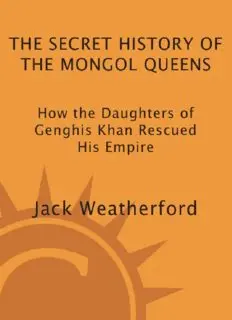
The Secret History of the Mongol Queens: How the Daughters of Genghis Khan Rescued His Empire PDF
Preview The Secret History of the Mongol Queens: How the Daughters of Genghis Khan Rescued His Empire
ALSO BY JACK WEATHERFORD Genghis Khan and the Making of the Modern World The History of Money Savages and Civilization: Who Will Survive? Native Roots: How the Indians Enriched America Indian Givers: How the Indians of the Americas Transformed the World Tribes on the Hill: The United States Congress—Rituals and Realities May the Golden Light of the Eternal Blue Sky forever bless the mothers and the daughters of the Great Mongol Nation CONTENTS Map of the Mongol Empire (1206–1368) INTRODUCTION The Missing Chapter PART I Tiger Queens of the Silk Route 1206–1241 1 It Takes a Hero 2 The Growling Dragon and the Dancing Peacock 3 Our Daughters Are Our Shields 4 Queens at War and Commerce PART II The Shattered Jade Realm 1242–1470 5 War Against Women 6 Granddaughters of Resistance 7 The Rabbit Demon’s Revenge 8 Daughter of the Yellow Dragon 9 The Falling Prince and the Rising Queen PART III Wolf Mother 1470–1509 10 The White Road of the Warrior Widow 11 Winning the War and Raising a Husband 12 Facing the Wall 13 Her Jade Realm Restored EPILOGUE The Secrets of History S B ELECTED IBLIOGRAPHY A N T OTE ON RANSLITERATION N OTES A CKNOWLEDGMENTS I NTRODUCTION The Missing Chapter , an unidentified hand N AN UNKNOWN DAY LATE IN THE THIRTEENTH CENTURY O clumsily cut away part of the text from the most politically sensitive section of The Secret History of the Mongols. The censored portion recorded words spoken by Genghis Khan in the summer of 1206 at the moment he created the Mongol Empire and gave shape to the government that would dominate the world for the next 150 years. Through oversight or malice, the censor left a single short sentence of the mutilated text that hinted at what had been removed: “Let us reward our female offspring.” In the preceding section of the text, Genghis Khan bestowed offices, titles, territories, and vassals upon his sons, brothers, and other men according to their ability and contribution to his rise to power. But at the moment where the text reported that he turned to the assembly to announce the achievements and rewards of his daughters, the unknown hand struck his words from the record. The censor, or possibly a scribe copying the newly altered text, wrote the same short final sentence twice. Perhaps the copyist was careless in repeating it, or perhaps the censor deliberately sought to emphasize what was missing or even to taunt future generations with the mystery of what had been slashed away. More than a mere history, the document known as The Secret History of the Mongols recorded the words of Genghis Khan throughout his life as he founded the Mongol nation, gave his people their basic laws, organized the administration, and delegated powers. It served as the biography of a tribe and its leader as well as the national charter or constitution of the nation that grew into a world empire. Only the most important members of the royal family had access to the manuscript, and therefore it acquired its name. The Secret History provides an up-close and personal view of the private life of a ruling family that is unlike any other dynastic narrative. The text records the details of conversations in bed between husband and wife; of routine family problems as well as arguments over who had sex with whom; and expressions of the deepest fears and desires of a family who could not have known that they would become important actors in world history. Many episodes and characterizations, particularly those regarding Genghis Khan’s early life, are unflattering. It was not written by sycophantic followers currying favor, but by an anonymous voice dedicated to preserving the true history of one of the world’s most remarkable men and the empire he founded. That did not mean that the history was available to just anyone, however. The Mongols operated possibly the most secretive government in history. They preserved few records, and those were written in the Mongolian language, which their conquered subjects were not allowed to learn. While Mongol khans gave away jewels and treasures with little evidence of covetousness, they locked their documents inside the treasury and kept them closely guarded. As Persian chronicler Rashid al-Din wrote in the thirteenth century: “From age to age, they have kept their true history in Mongolian expression and script, unorganized and disarranged, chapter by chapter, scattered in treasuries, hidden from the gaze of strangers and specialists, and no one was allowed access to learn of it.” Both the secrecy of the records and the apparent chaos in which they were kept served the purposes of the rulers. With such an unorganized history, the person who controlled the treasury of documents could pick and choose among the papers and hide or release parts as served some political agenda of the moment. If a leader needed to discredit a rival or find an excuse to punish someone, there was always some piece of incriminating evidence that could be pulled from the treasury. Following the example of Genghis Khan, the early Mongol rulers clearly recognized that knowledge constituted their most potent weapon, and controlling the flow of information served as their organizing principle. Genghis Khan sired four self-indulgent sons who proved good at drinking, mediocre in fighting, and poor at everything else; yet their
